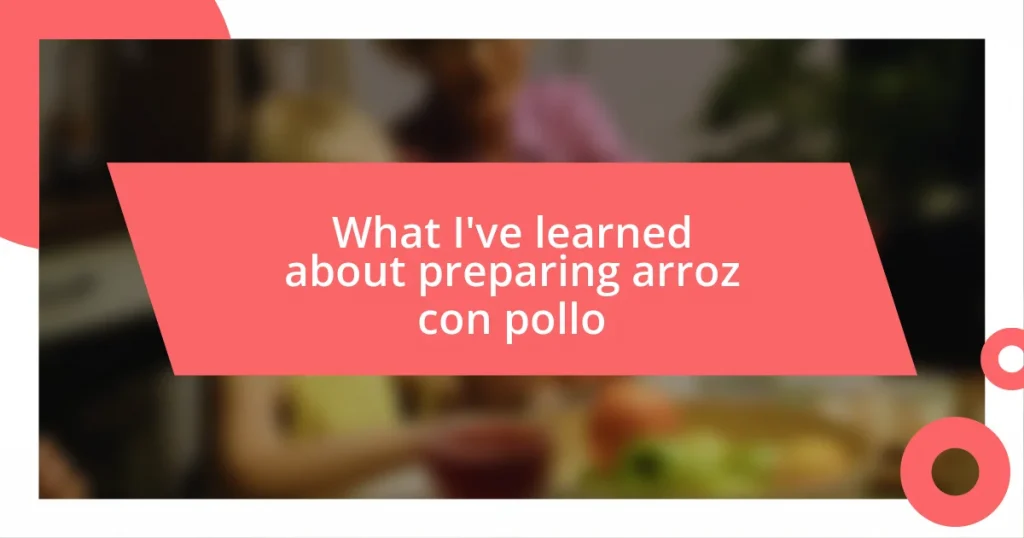Key takeaways:
- Sous-vide cooking enhances flavors and ensures even cooking, making it accessible for home chefs to achieve restaurant-quality results.
- Essential equipment includes an immersion circulator, vacuum sealer, heat-safe bags, and a pot or container for the water bath.
- Proper ingredient selection, precise cooking times, and thorough cleaning of tools are crucial for successful and enjoyable sous-vide cooking experiences.
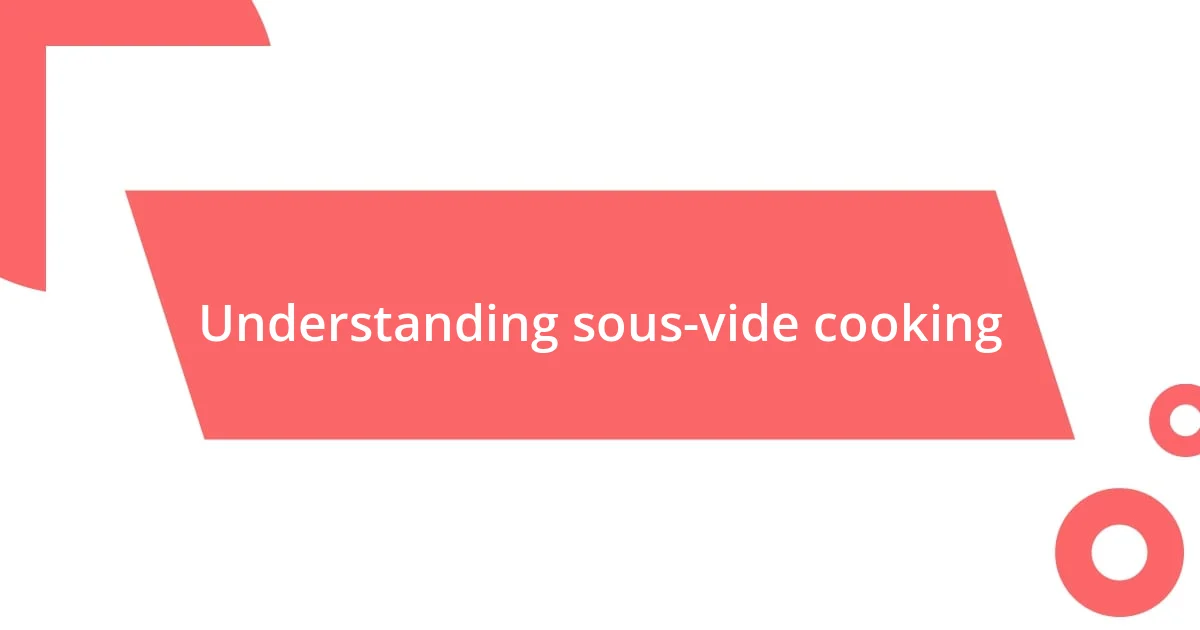
Understanding sous-vide cooking
Sous-vide cooking, a method that means “under vacuum” in French, absolutely transformed how I view meal preparation. Picture this: food sealed in a bag, submerged in a precisely maintained water bath, cooking evenly and retaining all those delightful flavors and nutrients. It’s a game changer; every time I take a bite of a perfectly cooked steak, I’m reminded of how this technique can elevate even the most basic ingredients.
When I first ventured into sous-vide, I was skeptical about whether it could really make a difference in flavor and texture. I remember the first time I cooked vegetables this way—they emerged vibrant and tender, bursting with freshness. How could cooking something for hours at a low temperature produce such profound results? It’s like accentuating the essence of the ingredients, making them shine in a way I had never experienced before.
This method truly shines in its simplicity and precision, allowing anyone to achieve restaurant-quality results at home. I often find myself pondering: isn’t it fascinating how a cooking technique used by top chefs can be accessible to all of us? Each time I sous-vide a piece of meat, I feel like I’m engaging in a secret ritual, one that connects me to the culinary world in a way I never thought possible.
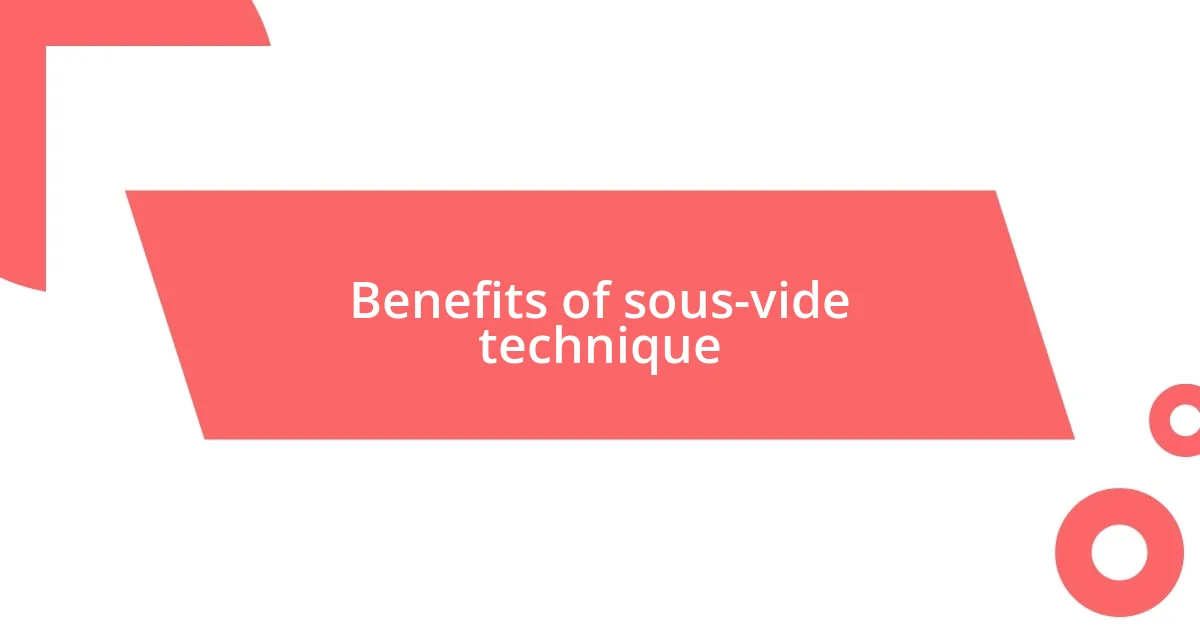
Benefits of sous-vide technique
The sous-vide technique offers incredible consistency. One of my first experiences with sous-vide was cooking a chicken breast. I set the temperature to a perfect 140°F (about 60°C) and left it for an hour. When it was done, the chicken was incredibly juicy and cooked evenly throughout. That consistency made it clear to me that sous-vide takes the guesswork out of cooking. I didn’t have to worry about overcooking my chicken or having dry spots.
Another benefit that stands out to me is the infusion of flavors. Recently, I decided to make a batch of garlic-infused olive oil using the sous-vide method. I combined fresh ingredients in a bag, sealed it tightly, and let it bathe in warm water for a couple of hours. The result was an oil bursting with flavor! This method allows flavors to meld in a way that traditional cooking often fails to achieve. It’s like joining forces with the ingredients, creating an experience that’s uniquely satisfying.
Not to mention, there’s a fantastic level of convenience with sous-vide cooking. I can prep meals ahead of time, set my sous-vide machine, and go about my day. I recall preparing a hearty beef stew in advance, and while I went about my busy day, the flavors were melding beautifully at a low temperature. When I returned home, the aroma welcomed me, and dinner was ready without any last-minute rush. It’s both freeing and rewarding, and I genuinely feel empowered by this simple yet effective cooking technique.
| Benefit | Description |
|---|---|
| Consistency | Sous-vide provides even cooking, eliminating the risk of over or undercooking. |
| Flavor Infusion | Allows for deep flavor melding, enhancing taste with precision. |
| Convenience | Pre-prepped meals can cook unattended, saving time for those with busy lifestyles. |
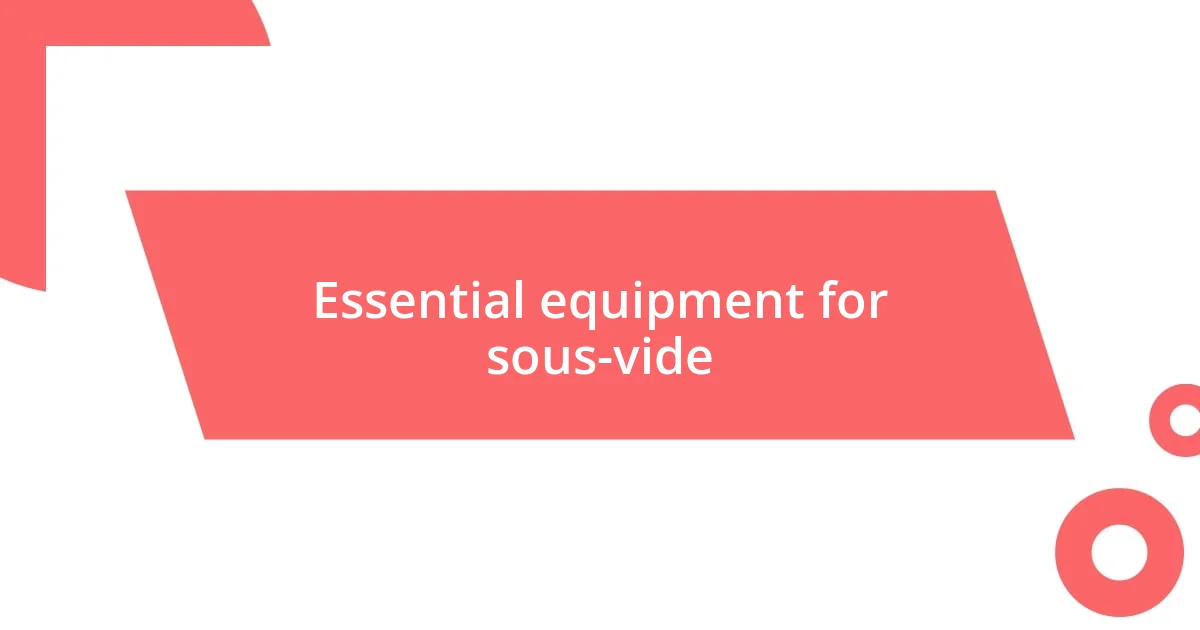
Essential equipment for sous-vide
The essential equipment for sous-vide cooking is straightforward yet vital for achieving the delicious results I’ve come to love. Initially, I was surprised by how relatively simple it is to get started. My first purchase was a good quality immersion circulator—this is the device that maintains the water temperature precisely, the heart of sous-vide cooking, if you will. I recall being a bit intimidated by the technical specs, but once I set it up and watched it work its magic, it felt like a culinary revelation.
Here’s what you need to create a successful sous-vide setup:
- Immersion circulator: The key device that controls the water temperature.
- Vacuum sealer: This ensures airtight seals on food bags, preventing water from getting in while keeping flavors locked in.
- Sous-vide bags: While zip-lock bags can work in a pinch, I found that durable, heat-safe bags perform much better for consistent results.
- Large pot or container: Something that can hold the water bath. I often use a stockpot or a dedicated sous-vide container to accommodate various recipes.
I remember the moment I first used my immersion circulator; I was eager yet nervous. I had chosen to sous-vide some pork chops, and honestly, I felt a mix of excitement and dread—what if I messed up? But as the peaceful sound of bubbling water filled my kitchen, I knew I was onto something special.
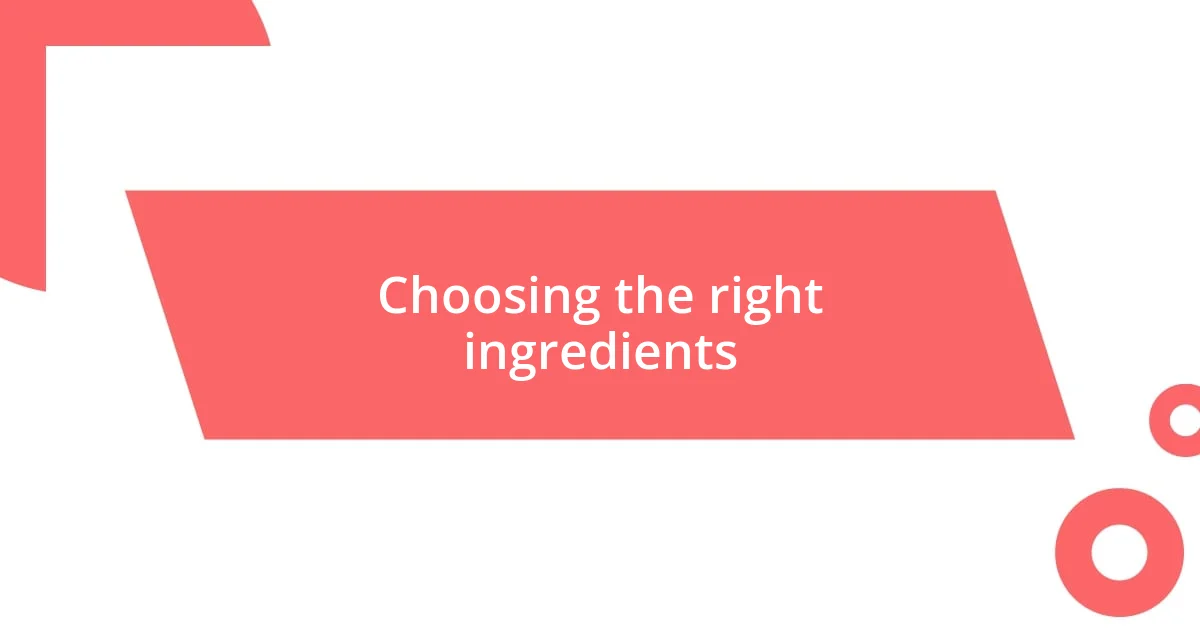
Choosing the right ingredients
When it comes to choosing ingredients for sous-vide cooking, fresh quality is key. I’ve learned that the best results come from using well-sourced produce and meat. For instance, when I decided to sous-vide asparagus, the difference between store-bought and farmer’s market produce was stark. The farm-fresh veggies retained their vibrant color and crispness in a way that made me wonder how I ever cooked without them. Have you ever noticed how the flavor of freshly picked herbs can transform a dish? It’s undeniable!
Another crucial aspect is understanding how different ingredients respond to the sous-vide technique. I remember my attempt at sous-vide egg bites. I was so excited, but I realized too late that the size and freshness of the eggs significantly impacted the final texture. Fresh eggs created an incredible creaminess, while older ones led to a somewhat rubbery outcome. This taught me the importance of ingredient selection—each component contributes to the overall experience.
Finally, don’t shy away from experimenting with combinations! One day, I decided to sous-vide tri-tip with a marinade of soy sauce, garlic, and ginger. I was slightly anxious about how the flavors would mingle during the cooking process. The outcome was incredible! The meat was not only tender but also infused with deep, rich flavors that made my taste buds dance. This experience solidified my belief that adventurous ingredient choices can lead to remarkable culinary adventures in sous-vide cooking. Have you ever discovered a surprising flavor combination that wowed you?
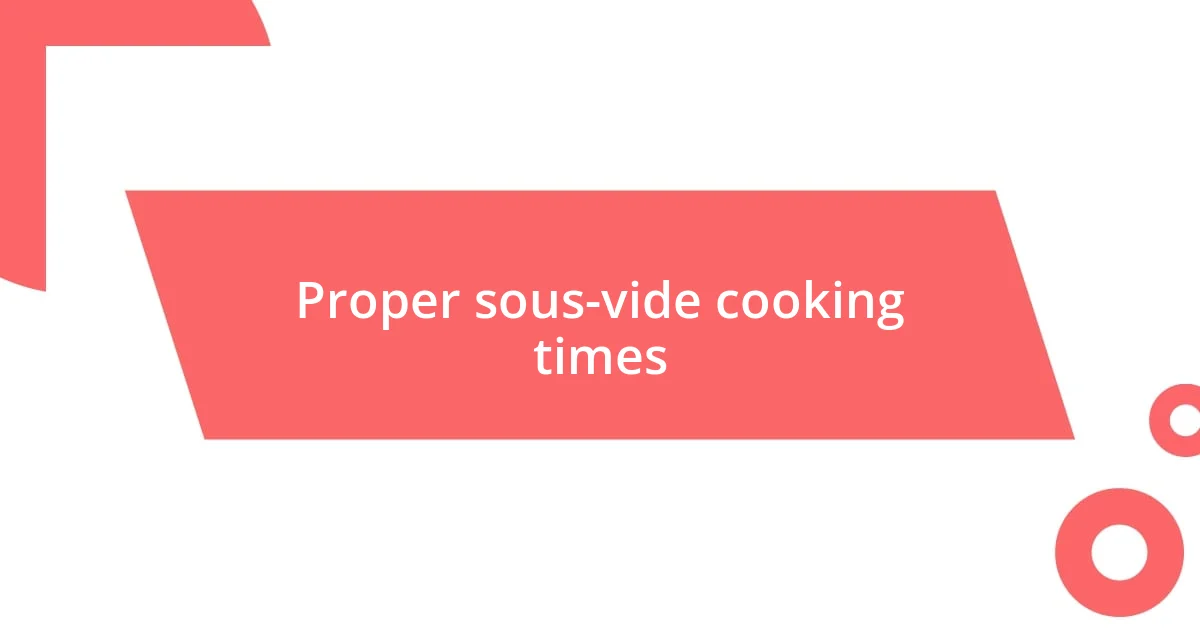
Proper sous-vide cooking times
When it comes to sous-vide cooking times, precision is everything. I remember my first attempt at cooking chicken breast, and the anxiety I felt about whether the cooking duration was just right. After some research, I learned that cooking chicken at 140°F (60°C) for about an hour results in a beautifully tender and juicy texture. It was such a relief to find that the low-and-slow method not only made the chicken succulent but also eliminated any fear of overcooking.
It’s fascinating how the thickness of the food plays a critical role in sous-vide timing. For instance, I’ve had great success with salmon fillets, cooking them for about 45 minutes at 125°F (52°C). Initially, I was skeptical; would such a short time really be enough? But each revealing moment as I unwrapped those fillets brought a new appreciation for the sous-vide technique. The fish was moist and flaky, far from the dry texture you sometimes get with traditional methods. Have you ever been surprised by a cooking shortcut that changed your outlook?
However, adjusting to proper cooking times can take a bit of practice. For steaks, I typically aim for 1-2 hours, depending on the thickness. I recall a time I briefly left a ribeye in the bath for three hours—talk about a late dinner! The steak was still fabulous, but the experience reinforced how important it is to keep track of cooking times. It’s all part of the learning curve, and isn’t that the beauty of sous-vide cooking? Each meal feels like a little experiment, and the outcomes are as varied as our culinary imaginations!

Tips for perfect results
One of my top tips for achieving perfect results in sous-vide cooking is to ensure your food is properly sealed. I once rushed through sealing a bag and ended up with water seeping in during cooking. It was such a letdown to see my carefully prepared dish diluted. To circumvent this, I’ve learned to use the water displacement method or invest in a good vacuum sealer. It makes all the difference! Did you ever have a cooking mishap that turned into a lesson?
Temperature consistency is another key factor. I remember a time when I thought I could skip preheating my water bath while preparing pork tenderloin. The result? It cooked unevenly, leaving me with a dry exterior and an undercooked center. Since then, I never skip this step. Have you ever underestimated the significance of temperature in your culinary endeavors?
Lastly, don’t forget to finish your dish with a quick sear. I’ve had moments where, despite a perfect sous-vide cook, the meat lacked that appealing caramelization. A sizzling hot skillet for a minute or two can elevate your dish to another level. It’s astounding how a little char can enhance flavors. So, have you considered that final touch to take your sous-vide creations from good to unforgettable?
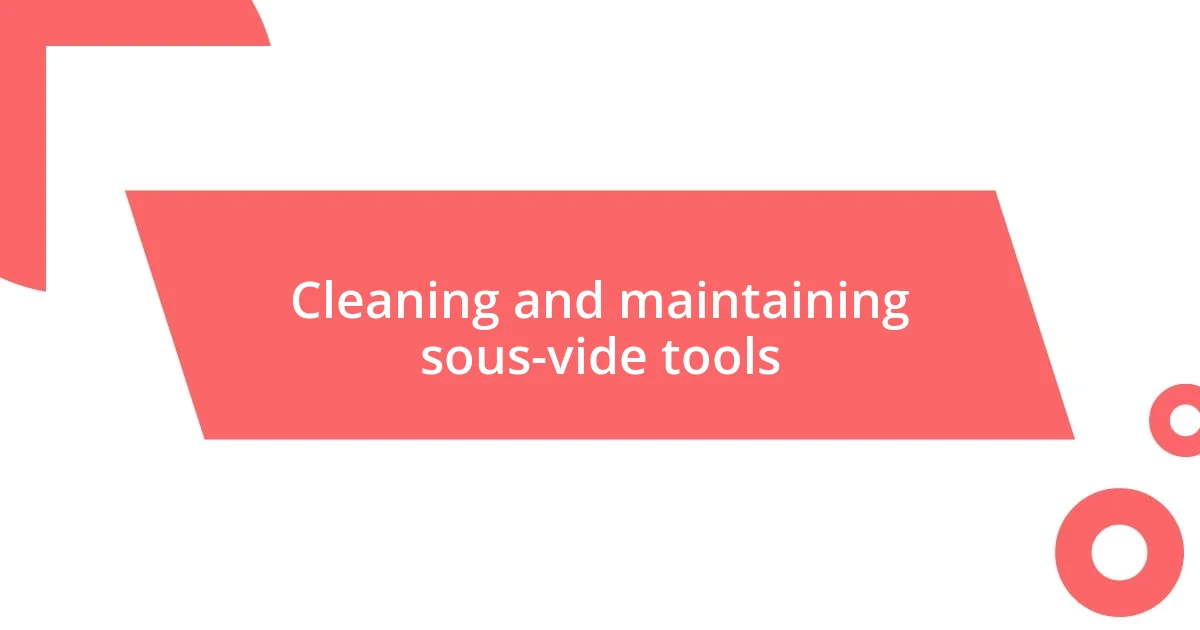
Cleaning and maintaining sous-vide tools
Cleaning sous-vide tools is often more critical than it initially seems. After my first few rounds of cooking, I realized that the water bath and bagging materials needed special attention to avoid cross-contamination. I remember one night when I thought I could just rinse everything quickly, only to find lingering odors the next time I used my immersion circulator. Now, I take the time to thoroughly wash my containers and any reusable bags or seals immediately after use. Trust me; it’s worth it to keep everything fresh and hygienic.
Maintaining my sous-vide equipment has taught me to appreciate the little details. For instance, I learned that regular descalings of my immersion circulator helps extend its lifespan. I once noticed a drop in performance, and after investigating, I discovered that mineral buildup was the culprit. Ever faced a tech hiccup just when you were excited to cook? This experience prompted me to create a routine for cleaning and maintaining my sous-vide tools, ensuring they’re always ready for my next culinary adventure.
Lastly, I can’t stress enough the importance of inspecting seals and bags for wear and tear. I had a bag give out mid-cook once, ruining not just the meal but my motivation too. Now, I’m diligent about checking for pinholes and frayed edges. Do you ever find yourself overlooking simple things? Making this a habit ensures that I can immerse myself in the joy of sous-vide cooking without any unexpected surprises. It’s these little maintenance tasks that keep the sous-vide experience enjoyable and stress-free!













